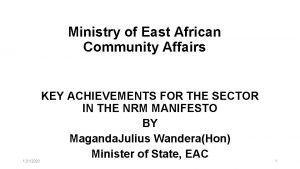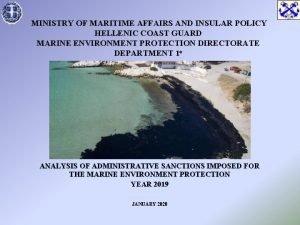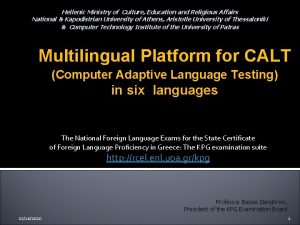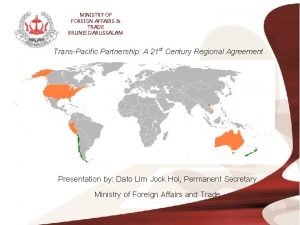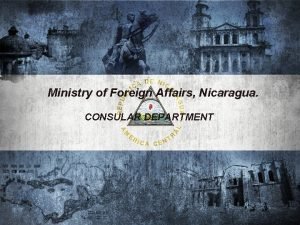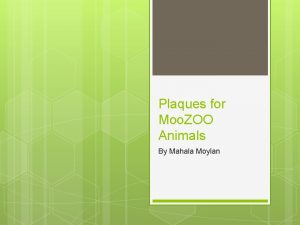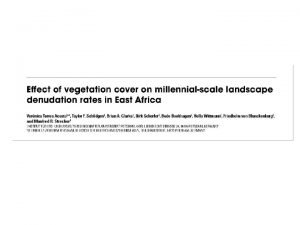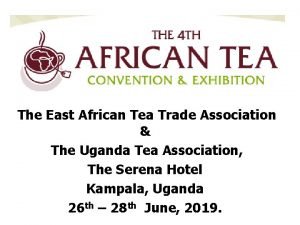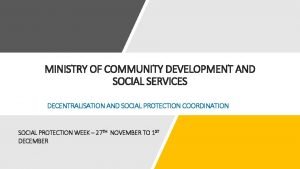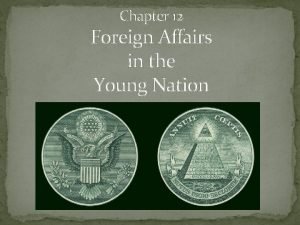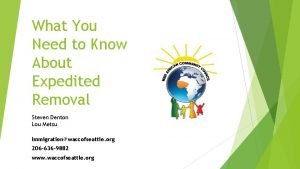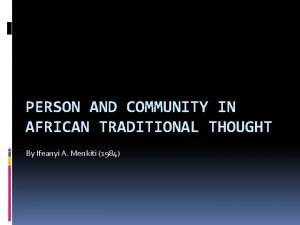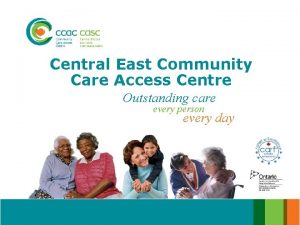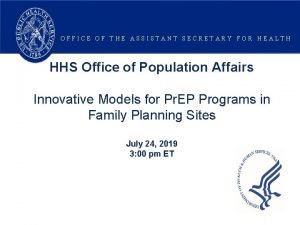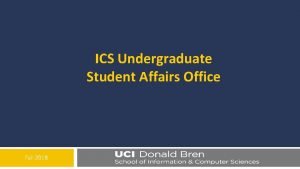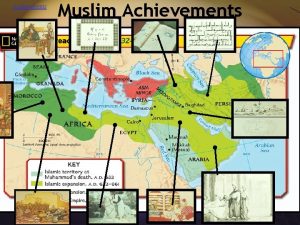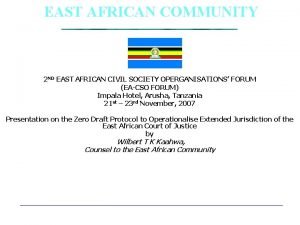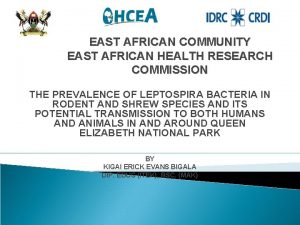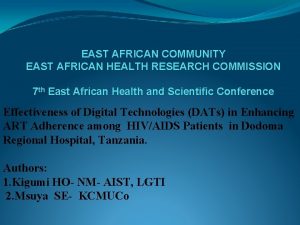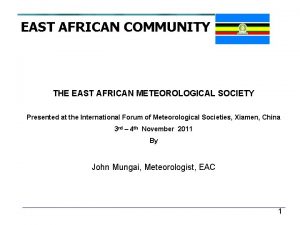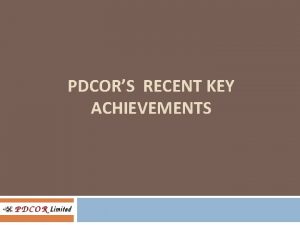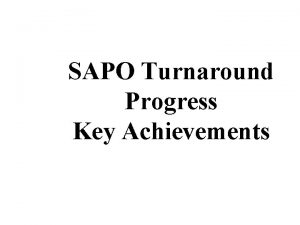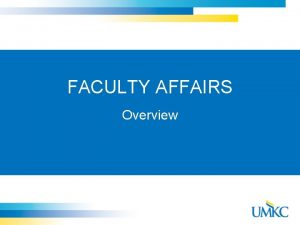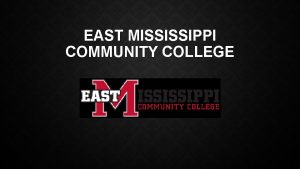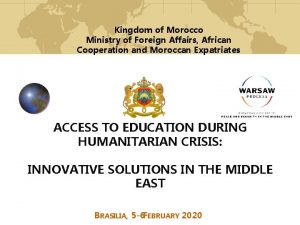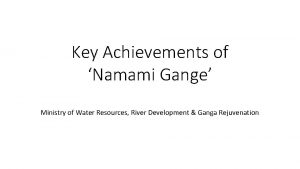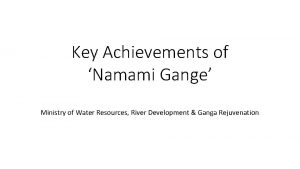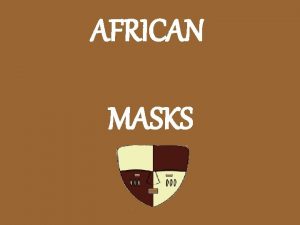MINISTRY OF EAST AFRICAN COMMUNITY AFFAIRS KEY ACHIEVEMENTS
























- Slides: 24

MINISTRY OF EAST AFRICAN COMMUNITY AFFAIRS KEY ACHIEVEMENTS IN THE NRM MANIFESTO By Maj. General Kahinda Otafiire Minister of East African Community Affairs May 2021 1

Structure i. Introduction ii. Ministry Vision, Mission, Mandate iii. Strategic Objectives iv. NRM Manifesto Commitments v. Achievements vi. Challenges vii. Way forward 2

Introduction • The Ministry of East African Community Affairs (MEACA) was created in 2007, in accordance with Article 8(3) of the Treaty for the establishment of the East African Community to “steer Uganda’s regional integration agenda in accordance with the objectives of the Treaty. • I am pleased to inform you that Article 8 of the Treaty for establishment of the East African Community (EAC) provides for Ministries responsible for EAC Affairs whose mandate is to coordinate and act as a focal point on all East African Community matters. As a Ministry, we have ensured that the aspirations of the NRM Manifesto (2016 -2021) in Chapter 17, towards attainment of International and Regional cooperation, that is beneficial to Uganda, has to a great extent been realised through the EAC. 3

Ministry Vision, Mission, Mandate • Vision: The Ministry vision is to have a “prosperous people in a secure federated East Africa” • Mission: The Ministry exists to “ensure that Ugandans participate in and benefit from the East African Community integration” • Mandate: The mandate is to “steer Uganda’s regional integration agenda in accordance with the objectives of the Treaty for Establishment of East African Community” 4

Ministry Strategic Objectives • In pursuit of the Ministry’s Vision; and in line with the Mission and Mandate, the Strategic objectives of the Ministry over the medium term are to: 1) Strengthen MEACA to provide Strategic leadership, guidance and support for EA integration 2) Coordinate and ensure compliance and implementation of EAC Policies, Laws, Decisions, Directives and Programmes. 3) Enhance public awareness and public participation in EAC regional integration. 4) Build and strengthen the capacity of MEACA to provide strategic leadership, guidance and support for EAC integration in Uganda 5

Manifesto Commitments 1. Pursuing a policy of commercial diplomacy to protect trade and investment. The NRM continues championing Uganda’s constructive contribution to regional and international economic development, peace and security, particularly through the EAC. 2. Fast-tracking implementation of national key infrastructure projects to enhance the country’s competitiveness while at the same time preparing to eventually fit into the EAC convergence criteria. 3. The Northern Corridor Integration Projects are critical to Uganda as they will facilitate trade between the country and the region. NRM will, therefore, remain committed to the full implementation of these projects basing on earnings from some of the country’s resources such as oil and gas, as well as minerals. 4. NRM will continue to pursue the engagement with other EAC member states to pursue and attain the realisation of an EAC 6

KEY ACHIEVEMENTS Customs Union • My Ministry has coordinated and participated in formulating enabling laws such as the EAC Elimination of NTBs Act and its regulations assented to by Heads of state and published in July 2017 and full operationalization of the EAC Single Customs Territory (SCT) among others that have made significant impact on trade in goods by lowering the cost of doing business and improved Uganda’s share of trade e. g, in Fiscal Year 18/19, EAC continued to be the largest destination for Uganda’s Exports; amounting to $1, 469 million compared to $911 million in the previous year ü Transit times have greatly improved along the Northern Transport Corridor from about 21 days to 2 -5 for a container of goods to move from Mombasa to Busia. ü Simplified Trade Regimes for small traders engaged in cross-border trade with goods less than 2000 USD have been put in place to transact duty free. ü One only needs a certificate of Origin from Uganda Revenue Authority and Ministry of Trade, Industry and Cooperatives to facilitate cross border movement of goods. This has resulted into an increase in the number of simplified Co. O issued implying an increase in formal trade between Uganda and other Partner States. 7

Customs Union Cont’d • The One-Area Network for the mobile phone industry was negotiated and is operational in Uganda, Rwanda and Kenya. The one–area network reduces the telephone call costs significantly, hence the cost of doing business for business persons engaged in regional trade. • Review of the EAC Common External Tariff: Partner States have adopted a four-band Common External Tariff (CET) structure (0%, 10%, 25% and a rate above 25%). Partner States have further agreed on products that will be classified under the rate above 25%. • Authorized Economic Operators (AEOs): The number of regional AEOs increased to 133 Authorized Economic Operators (AEOs). • Implementation of the EAC Standardization, Quality Assurance Metrology and Testing (SQMT Act 2006): A total of 72 standards were harmonized and approved; 148 international standards normatively referenced in the harmonized standards were endorsed for adoption by Partner States. 8

The EAC Common Market • The Ministry continues to coordinate and participate in the progressive implementation of the EAC Common Market and this has made profound impact on the lives of the EAC citizenry by easing the movement of goods, services, labour, persons and capital within the region. • Construction and operationalization of the One Stop Border Posts (OSBPs) üThe region has continued to operationalize the One Stop Border Posts (OSBPs). During the period under review, EAC One Stop Border Post (OSBP) Sustainability Strategy was developed and adopted. Further, OSBP Performance Measurement Tool was developed and adopted. Furthermore, EAC launched additional 2 OSBPs (Nimule/Elegu (Uganda/South Sudan border) and Tunduma (Tanzania/Zambia border) in the Financial Year 2019/2020. This led to an increased number of OSBPs that are operational from 13 to 15. So far, the average time to cross One Stop Border Posts has reduced by 84%. 9

EAC Common Market Cont’d • Travel documents üFollowing launching of the New International EA e- Passport at the sitting of the 17 th Summit of EAC Heads of State held on 2 nd March 2016, all Partner States save for the Republic of South Sudan, are issuing the EA e- Passport to their citizens, a process that we keenly participated in and coordinated. üNational Identity Cards are used to travel between Uganda, Kenya and Rwanda • Facilitation of movement of persons, labour and refugee management üFor the purpose of facilitating Free Movement of Persons in the Community, a draft policy on e - Immigration, has been developed and awaits final validation. In addition, a draft Labour Migration Policy to facilitate the implementation of the EAC Common Market Protocol provisions on free movement of workers has been developed and awaits regional validation. Also, a draft policy on EAC Refugee management, that provides for a common mechanism for management of Refugees in the Community has been developed and is undergoing final review in the Partner States 10

EAC Common Market Cont’d • Roads ü The EAC continued to mobilize resources to carry out studies for preparation of road projects under the multinational arrangement. During the period, the preparation for the multinational Uganda – Tanzania road was concluded and resources mobilization for construction has commenced ü My Ministry has participated in regional negotiations that realized projects such as the Ntungamo–Mirama Hills/Kakitumba road (37 km) which has been constructed to link to Mirama Hills OSBP and ease connectivity to the Rwanda Market; The Kapchorwa. Swam (78 km) road linking Uganda to Kenya has been constructed ü Total EAC Road Corridor Network Length 14, 460 km, but critical for Uganda are: i. Northern Corridor Mombasa: Nairobi – Nakuru – Eldoret – Bungoma – Malaba – Bugiri – Jinja – Kampala – Masaka – Katuna/Gatuna – Kigali – Nemba/Gasenyi – Ngozi - Kayanza – Bugarama – Bujumbura-Corridor Length- 2, 080 km ii. Central Corridor: Dar es Salaam – Morogoro – Dodoma – Singida – Nzega – Tinde – Isaka - Lusahunga to: (i) Gisenyi via Rusumo and Kigali (ii) Bujumbura via Nyakasanza, Kobero and Gitega (iii) Masaka via Bukoba and Mutukula; Corridor Length- 2, 170 km iii. Gulu Corridor: Nimule – Bibia – Gulu – Lira – Soroti – Mbale – Tororo- Corridor Length- 600 km 11

EAC Common Market Cont’d • Civil Aviation üThe EAC Secretariat coordinated the implementation of EAC Seamless Upper Airspace Project and this included the harmonization of regulations, Manuals of Air Navigation Services operations and development of common Secondary Surveillance Radar (SSR) codes. The Secretariat completed data collection and verification for integration of South Sudan into the EAC Seamless Upper Airspace Project. 12

Implementation of Key National Infrastructure Projects • Uganda Cancer Institute has been designated as the East African Centre of Excellence for Oncology • Uganda Virus Research Institute (UVRI) was designated as the EAC Regional Centre of Excellence for Virology. It will detect and rapidly respond to Epidemic/pandemic prone diseases such as Ebola, Marburg, Cholera, HIV and Tuberculosis that are prevalent in the EAC. • EAC Mobile Laboratories Project ü We coordinated and participated in negotiations to sign a 3 -year financing and project implementation agreement with the Government of the Federal Republic of Germany through the German Development Bank Group (Kf. W) to support the establishment and operationalization of the “EAC Regional Network of Public Health Reference Laboratories for Communicable Diseases” Project. ü The project has installed nine (9) mobile laboratories in all the Partner States. Out of the nine 13 modular designed mobile laboratories, Uganda has already received two (02)

Trade and Investment Performance • Investment ü Total intra-EAC investments grew both in numbers and value in 2019. The number of projects increased by 23. 3 percent from 60 projects to 74 projects, whereas the value of investment increased by 374. 5 percent from US$ 152. 7 million in 2018 to US$ 724. 6 million in 2019. ü FDI inflows to the EAC in 2019 were concentrated in Transport, Communication & Storage (US$ 2. 61 billion); Manufacturing (US$ 1. 84 billion); Finance, Insurance, Real estate and Business services (US$ 1. 74 billion); and Mining and quarrying (US$ 1. 24 billion). • Resolution of Non-Tariff Barriers ü As of January 2020, a total of 16 NTBs were resolved through bilateral meetings, national and Regional monitoring committees. The EAC elimination of Non-Tariff Barriers Act, 2017 was revised and the regulations for implementing the Act were finalized. • Trade Performance ü The EAC Merchandise trade grew by 7. 8 percent to US$55. 3 billion in 2019 from US$51. 3 billion in 2018. The growth in merchandise trade resulted from a large increase in the growth of exports from the region to the rest of the world during the year. Total EAC exports increased by 10. 9 percent to US$15. 8 billion in 2019 from US$14. 2 billion in 2018. ü Uganda’s intra-regional exports fell by 23. 8 percent to US$956 million in 2019 from US$1, 254. 5 million in 2018. Most of the goods in inra-regional trade were finished manufactured goods, demonstrating the country’s growing industrial base in manufactured goods ü The EAC remains the major source of imports for Uganda, with imports growing by 59. 5 percent to US$1. 3 billion in 2019, from US$796. 3 million in 2018. 14

The EAC Monetary Union My ministry coordinated and participated in negotiations that culminated in the signing of the Protocol for the establishment of the East African Monetary Union on 30 th November 2013; setting out the process and convergence criteria for attainment of a Monetary Union in the EAC region over a period of 10 years. The Protocol provides for the establishment of four institutions to support the Monetary Union. These are: i. The East African Monetary Institute (EAMI); ii. The East African Statistics Bureau; iii. The East African Surveillance, Compliance and Enforcement Commission, and iv. The East African Financial Services Commission. 15

The EAC Monetary Union Cont’d • The bill for establishment of these four EAMU Institutions have been developed and are in various approval processes i. e. i. The East African Monetary Institute (EAMI) bill was passed by EALA, and assented to by all the EAC Heads of State on 1 st February 2019. ii. The East African Statistics Bureau (EASB) bill was considered and passed by EALA, awaiting assent by the EAC Heads of State. iii. The East African Surveillance, Compliance and Enforcement Commission (EASCEC) bill has been submitted to the EAC Sectoral Council on Legal and Judicial Affairs (SCLJA) before its submission to EAC Council of Ministers and thereafter to EALA. iv. The bill for the establishment of the East African Financial Services Commission (EAFSC) is still being developed. v. It is envisaged that by 2024, a common currency shall be introduced to replace the national currencies of Partner States 16

EAC Political Federation • Pursuant to the 17 th Summit Decision which adopted Political Confederation as a transitional model to Political Federation and the subsequent 20 th Summit guidance, the EAC is currently engaged in the drafting of the EAC Confederation Constitution; • The constituted team of experts from Partner States has so far finalized with a situational analysis and National Consultations on the envisaged constitutional arrangement commenced in August 2019 in the Republic of Burundi and April 2021 in the Republic of Uganda; • Uganda is represented by Hon. Dr. Justice Benjamin Odoki (retired CJ of Uganda) and prof. Murindwa Rutanga (Lecturer Makerere University) 17

EAC Political Federation cont’d • The Key Issues for consultations were: üWhat should be the areas of cooperation under the Political Confederation? üHow should the governing structure of the Political Confederation be? üWhat should be the modes of decision-making by the Confederal authority? üWhat should be the governance principles of the Confederation? üHow should the National States relate to the Confederal authority? üHow should the operations of the Confederal authority be funded? üHow should the Constitution establishing the Political Confederation be adopted? Any other issues proposed by stakeholders to be addressed in the Constitution of the EAC Political Confederation 18

EAC Political Federation cont’d • Why EAC Must Integrate/confederate? üProsperity for the People üStrategic Security üFraternal Relations 19

Challenges to Intra- EAC Trade Despite the growth in intra-EAC trade, the growth was slower (at a rate of 6. 2 percent) than the African Average which stands at about 20 percent. The slower than expected growth in intra-EAC exports was attributed to the following challenges: a. Similarity in the commodities produced in the region. As such, agricultural and industrial products across the region are homogenous with little scope for intra-EAC trade. b. Continued use of ‘Stay of Application’ to import commodities resulting in a restriction in intra-EAC of commodities that were imported under that arrangement. These include rice and sugar c. Prevalence of NTBs and other measures of equivalent effect that affected trade and trade facilitation in the region. d. Growing competition from goods produced outside the region. Particularly from South Africa, Egypt , the Far East and Brazil e. Restriction on intra-EAC trade of 20 percent on commodities that benefitted from remission or were produced in Export Processing Zones. 20

Other Challenges i. Slow pace of harmonization of National sectoral laws to align them with the ratified EAC Protocols and frameworks; ii. Slow pace of mainstreaming of EAC programmes into the plans & budgets of the different sectors at national level; iii. Trade disputes and mistrust among member states threaten to scuttle efforts to integrate the East African Community into a single economic and political bloc. Hardline positions taken by the member states on various issues affecting the region has watered down provisions in the Treaty, which provides for peaceful settlement of disputes. 21

Way Forward 1. Fast. Track the completion of the Monetary Union 2. Fast Track the EAC Political Confederation to get a confederal Authority to drive the other pillars 3. Continue with bilateral engagements to remove Non- Tariff Barriers 4. Fast-track the development and implmentation of the EAC Heads of State infrastructure projects among others incluing These include the Jinja – Kampala Highway (76. 8 Km), the Southern By-Pass (17. 7 Km), the Kampala – Mpigi Highway (30 Km), the Masaka - Mutukula – Kyaka-Bugene-Kaslo– Kumunazi road, Construction of the Oil refinery in Hoima and development of the Crude Oil Pipeline among others 5. The Ministry will continue to coordinate and support the EAC Constitutional experts throughout the process of drafting and consulting on the East African Confederation Constitution 22

Conclusion • Despite the numerous challenges faced by the EAC integration process, a lot has been achieved as highlighted above; and more is yet to come from the bigger market perspective, transboundary infrastructure development, increased and improved regional security as well as industrial efficiency arising out of economies of scale. The Ministry therefore remains committed to NRM’s doctrine of good neighborliness and working together with other Partner States to promote Regional Integration. 23

For God and My Country 24
 Ministry of east african community affairs uganda
Ministry of east african community affairs uganda Ministry of maritime affairs and insular policy
Ministry of maritime affairs and insular policy Hellenic ministry of education and religious affairs
Hellenic ministry of education and religious affairs Ministry of foreign affairs and trade brunei darussalam
Ministry of foreign affairs and trade brunei darussalam Ministry of foreign affairs nicaragua
Ministry of foreign affairs nicaragua What religion is east africa
What religion is east africa Rift valley plate boundary
Rift valley plate boundary Rania onca animal
Rania onca animal East african rift
East african rift East african tea trade association
East african tea trade association Fdic community affairs
Fdic community affairs Ministry of community development
Ministry of community development Lesson 12 foreign affairs in the young nation
Lesson 12 foreign affairs in the young nation Horizontal movement of air
Horizontal movement of air Near east vs middle east
Near east vs middle east East is east and west is west
East is east and west is west West african community council kent
West african community council kent Person and community in african thought
Person and community in african thought Roman empire greatest achievements
Roman empire greatest achievements Central east community care access centre
Central east community care access centre Business canvas example
Business canvas example Business model canvas tripadvisor
Business model canvas tripadvisor Community action cycle for community mobilization
Community action cycle for community mobilization Hhs office of population affairs
Hhs office of population affairs Ics building uci
Ics building uci
